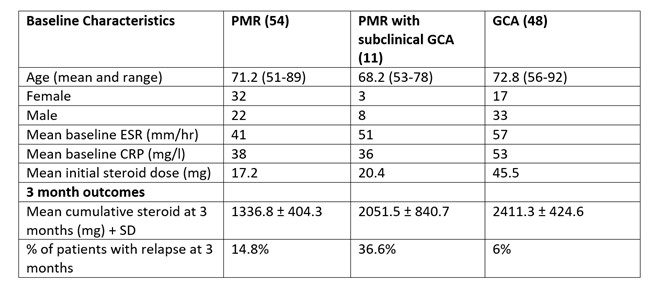Session Information
Date: Monday, November 13, 2023
Title: (1554–1578) Vasculitis – Non-ANCA-Associated & Related Disorders Poster II
Session Type: Poster Session B
Session Time: 9:00AM-11:00AM
Background/Purpose: It has been reported that up to a quarter of patients with polymyalgia rheumatica (PMR) have subclinical giant cell arteritis (GCA). It is currently uncertain if the presence of this finding may predict clinical outcomes in PMR.
Methods: 65 newly diagnosed PMR patients who met a clinical diagnosis for PMR were examined with ultrasound of their temporal and axillary arteries at time of diagnosis. US of all 6 branches of the superficial temporal arteries and both axillary arteries was performed using a GE P9 device. Sonographic abnormalities considered indicative of vasculitis in the temporal arteries included the halo sign and non-compressible arteries with a thickened intima-media complex. An intima-media thickness of 0.42mm for the common superficial temporal branch, 0.34mm for the frontal branch, and 0.29mm for the parietal branch was considered positive. In the axillary arteries, a halo sign, and an intima-media thickness of >1.0mm was considered positive. Halo scores were calculated for positive cases. Clinical, ultrasound and laboratory characteristics were recorded at baseline, 1 month and 3 months. Ultrasound findings were compared to a cohort of 48 GCA patients.
Results: 65 patients with a clinical diagnosis of PMR and 48 patients with a diagnosis of GCA were included in the study. 58 (89%) of the PMR patients met the 2012 ACR/EULAR PMR classification criteria (those who did not meet this classification were primarily due to prior corticosteroid use in primary care resulting in normal ESR/CRP). All 48 GCA patients met the 2022 ACR/EULAR GCA classification criteria. 20.3% of patients with PMR had evidence of subclinical GCA on ultrasound of their temporal and axillary vessels. The mean initial prednisolone dose initiated for PMR was 17.2mg, while those with subclinical GCA in PMR were started on a mean of 20.4mg prednisolone and those with GCA were on average started on 45.5mg of prednisolone. The mean cumulative corticosteroid dose at 3 months was 1336.8mg ± 404.3mg for PMR, 2051.5mg ± 840.7mg for subclinical GCA in PMR and 2411.3 ± 424.6 in GCA. PMR with subclinical GCA had significantly more cumulative corticosteroid than those with pure PMR (p=0.0069). Patients with subclinical GCA in PMR were more likely than either those with PMR or GCA patients to experience a relapse, with 36.6% of patients having a minor relapse, compared to 14.8% of the PMR group and 6% of the GCA group having a minor relapse in the first three months of treatment.
Conclusion: The presence of subclinical GCA in PMR at baseline predicts increased cumulative steroid dose at three months compared with PMR alone. Patients with subclinical GCA in PMR are also more likely to have a clinical relapse in the first three months of treatment than those with either PMR or GCA.
To cite this abstract in AMA style:
Cowley S, Kirby C, Harkins P, Conway R, Kane D. Baseline Vascular Ultrasound of Polymyalgia Rheumatica Patients at Time of Diagnosis Predicts Clinical Outcomes at 3 Months [abstract]. Arthritis Rheumatol. 2023; 75 (suppl 9). https://acrabstracts.org/abstract/baseline-vascular-ultrasound-of-polymyalgia-rheumatica-patients-at-time-of-diagnosis-predicts-clinical-outcomes-at-3-months/. Accessed .« Back to ACR Convergence 2023
ACR Meeting Abstracts - https://acrabstracts.org/abstract/baseline-vascular-ultrasound-of-polymyalgia-rheumatica-patients-at-time-of-diagnosis-predicts-clinical-outcomes-at-3-months/

